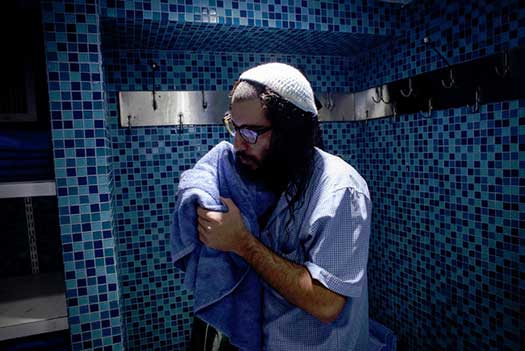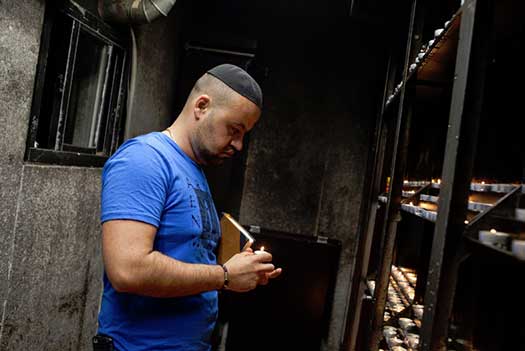
NYT: Jews Make Pilgrimage to the Rebbe
At midnight on Wednesday, Gaby Danieli stepped into the warm night on Francis Lewis Boulevard in Queens, the locks of hair flowing from each temple still sopping wet. He had just dunked in a Jewish ritual bath built beneath a modest house, and was ready for a visit to the grave of Rabbi Menachem Mendel Schneerson, the seventh grand rebbe of the Lubavitcher group of Hasidic Jews.
Mr. Danieli, an instructor at Yeshiva University, was not alone: all night long, men in black skullcaps and swishing fringes, women with designer pocketbooks, and young men in denim and T-shirts headed into Old Montefiore Cemetery in Cambria Heights to squeeze in one last prayer in the fleeting days before Yom Kippur, which began on Friday evening and ends on Saturday evening.
In the nearly 20 years since the [passing] of the rebbe, as Rabbi Schneerson was known, what began as a spontaneous pilgrimage has evolved into a spiritual touchstone of the religious movement he spawned, complete with its own rituals, controversies and supplicants from all corners of the globe.
And, perhaps in a nod to the famously sleepless city where the rebbe lived, preached and [passed], his grave site is open night and day.
The site is known as the ohel, and refers to the structure built around the resting place; the house abutting the cemetery is the Ohel Chabad Lubavitch Center. Pilgrimages to the site began almost immediately after the rebbe [passed] in 1994, said Rabbi Abba Refson, director of the center.
The faithful cite the rebbe’s magnetism and utopian ideals — he pioneered drug treatment centers for Jews and non-Jews alike, urged Jews to more deeply embrace their faith and sought to reinvigorate the Hasidic community, which had been decimated during the Holocaust — when they explain why, nearly two decades later, they still come, seeking a sense of nearness.
Today there is a brightly lighted, air-conditioned complex in the cemetery, with touch-screen terminals that have credit card readers for donations. A dozen houses nearby are owned by the Chabad Lubavitch organization, and there are two ritual baths, called mikvahs.
In the small hours of Thursday morning, visitors sat in the center beside a giant picture of the white-bearded rebbe, scribbling prayers on notepaper to be tossed onto the grave.
The rebbe, the belief goes, will deliver them to God.
As they stood around the burial place, men swayed and keened in the lamplit dark. Staring at the piles of prayers, a woman quietly wept. They prayed for healing, for themselves and for the world, reading off names of the sick and wishes for friends and family. They committed themselves to carry on the rebbe’s mission, and stayed for the pleasure of being so near the memory of a man viewed as so righteous that the ground in which his body lies is sacred.
Around 1 a.m., Tamar Elhyani, 66, of Fresh Meadows, Queens, had just finished casting her paper scraps. She said the rebbe helped grant her wishes: to finally become pregnant when she was in her 40s, and later, for her daughter to marry, which she did last week. Ms. Elhyani was not finished with her wishing: “This time I pray for her to get kids.”
Just past 2, Rabbi Refson strode out to the grave to deliver prayers from people who could not make it in person. They had been faxed and e-mailed, or dictated over the phone.
Secular Jews as well as the deeply observant arrived in droves, wending around the tombstones and noshing on the kosher chocolate-chip cookies that have become a quirky staple here; the center typically goes through 780 pounds of cookies in a week.
During the High Holy Days, a number of people stay overnight in the cemetery parking lot, some in luxurious R.V.’s.
“It’s quite the event,” said Rob Tischler, the chief executive of Allstar Coaches, which rents out the vehicles for holy day festivities. “We get these coaches back and it’s like they’ve been in a college dorm. They pull up at the cemetery and they just rock and roll.”
The pilgrimage to Cambria Heights, a largely black, middle-class neighborhood, has faced some challenges. Large celebratory crowds have frustrated neighbors, and efforts at expansion — most recently, a proposal for a more permanent structure than the tentlike ohel — have been met with opposition by the local community board. The center has made efforts to streamline parking, and in June, delivered bottles of wine to neighbors on surrounding streets, Rabbi Refson said. The number of visitors commemorating the rebbe’s death now tops 30,000.
On Thursday morning at 2:10, however, serenity ruled. Jake Kabili, 26, and four friends from Brighton Beach, Brooklyn, arrived wearing backward baseball caps, after finishing their shifts at kosher schnitzel and fast food restaurants. They sat quietly on benches scribbling down prayers, their iPhones beside them.
At 3 a.m., Ira Leibowitz, 44, who sells closeout merchandise, arrived to pray. Just hours before, he had arrived from Los Angeles, and at 5 a.m. he would head back to the airport.
Under jagged trees in the cemetery, sheaves of notes were piled several feet deep, rustling in the night wind. Candles flickered on shelves, their rising flames symbolizing the soul striving for its higher purpose.
At 4 a.m., Mendy Holtzberg, 17, who had just arrived from Israel, paced the sidewalk on Francis Lewis Boulevard, on the phone with his mother.
Inside, his father, Israel, a kosher butcher, slept on a bench. At dawn, Mr. Holtzberg awakened, to go to Crown Heights for kapparot, a pre-Yom Kippur ritual in which thousands of chickens are slaughtered. Inside his luggage were gleaming blades of varying thicknesses, ready for what he described as a difficult job.
“Better,” Mr. Holtzberg said, “to work in computers.”
Suddenly, Shmuly Raskin, who said he worked in the food business, sprinted by with a briskness usually reserved for the subway system. “I have to get to work and to pray,” he said, striding away. “I want to get a good word in.”
But not everyone visiting the grave of the rebbe was there to ask for something that night. Some, like Rabbi Jehoshua Raskin, said their prayers had long ago been answered. In 1947, the rebbe’s prayers and financial support helped him escape Communist Russia, he said.
The screen saver on his phone was a picture of the rebbe. The ringtone was the rebbe’s voice calling out encouragement.
“I cannot say the words ‘passed away,’ ” Rabbi Raskin said, “because the man did not pass away for me.”















last pictures caption
“lighted”? Did they author of the article take english????
Milhouse
The quality of proofreading at the NY Times is deplorable, and has been for at least 20 or 30 years. One presumes that the writer did take English, but its’ a proofreader’s job to catch this sort of error, and the NYT’s are incompetent.
Joe
Most likely. Did you? If you did, you might have known that although more commonly used as a past participle, “lighted” is an acceptable alternative to the irregular verb “lit”.
correct
yes, please learn English, clearly you lack in your knowledge of the English language.
in addition, the writer does not write the caption on the pictures..
great article!
NYT
Do you expect better from the New York Times?
Milhouse
The use of “lighted” in the caption is actually OK, but not the one in the article itself. “A brightly lighted complex”?! Give me a break. A place can be “lighted”, as in “provided with lights. But as a synonym for “illuminated” the correct word is “lit”.
to #1
The word “lighted” and “lit” can be used interchangeably and are both grammatically correct.
You can accuse the NYT of a lot of things, but the quality of its writing and its editorial oversight are very solid.
Milhouse
You have got to be kidding. The NYT’s standard of copy-editing and proofreading is atrocious. It’s almost as bad as their fact-checking, which is almost non-existent.
Grammar
http://www.englishrules.com/writing/2006/lit-and-lighted/
tuvia teldon
now I know why on yom kippur a well to do goy from Westchester drove to the ohel and told me he came to see what the Ohel was all about. he was learning about the Rebbe and so impressed by what he read. I guess he reads the Times.
someone got their facts wrong
Yehoshua Raskin did not leave Russia in 1947. He is bentzi’s son.
So it was either Bentzi, Michel, or Berel. But not Yehoshua.
Why can’t these facts get checked???